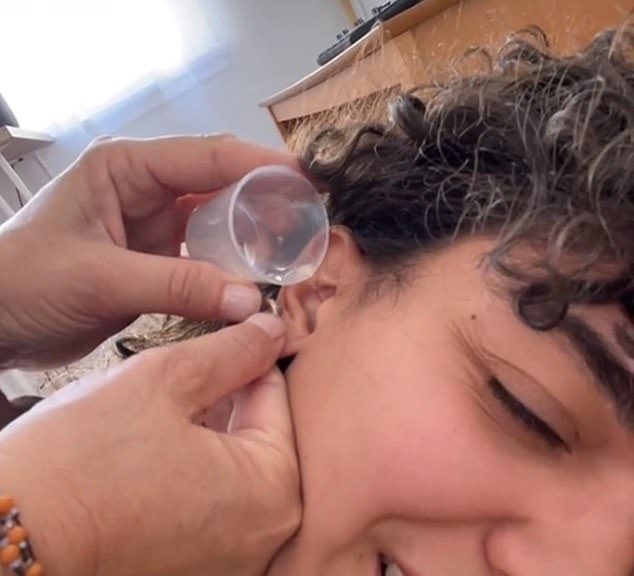AI algorithm that detects brain defects could help cure hard-to-detect epilepsy, study suggests
- Epilepsy affects one in 100 Britons and Americans and causes seizures
- One cause is a subtle abnormality that doctors struggle to detect on brain scans.
- But the algorithm can now detect changes that doctors couldn’t find
By Emily Craig Health Reporter for Mailonline Y John Ely, Senior Health Reporter for Mailonline
Published: | Updated:
Scientists have developed an AI that detects early signs of epilepsy that even experienced doctors might miss.
It was able to detect six out of 10 patients with a rare form of the condition, compared to an MRI that detected none.
Epilepsy, which affects one in 100 Britons and Americans, causes uncontrolled bursts of electrical activity in the brain that trigger seizures.
One cause of epilepsy is drug-resistant focal cortical dysplasia (FCD), a subtle abnormality in the brain that causes signals to fail.
It can only be treated with surgery. But the changes it causes in the brain are so subtle that even experienced radiologists can miss them when examining MRI images.
But a team at University College London developed an algorithm that caught the 63 percent of FCD cases that doctors had previously missed.
The researchers said their model could open up brain surgery to more people with epilepsy and offer them the chance of a cure.

A team at University College London developed an algorithm that detects drug-resistant focal cortical dysplasia (FCD), a subtle abnormality in the brain that causes epilepsy. Pictured: Brain abnormalities identified by the algorithm (highlighted in lime green) in MRIs of children and adults with epilepsy from around the world
WHAT IS EPILEPSY?
Epilepsy is a condition that affects the brain and leaves patients at risk of seizures.
Around one in 100 people in the UK have epilepsy, statistics from Epilepsy Action reveal.
And in the US, 1.2 percent of the population has the condition, according to the Centers for Disease Control and Prevention.
Anyone can have a seizure, which does not automatically mean you have epilepsy.
More than one episode is usually required before a diagnosis.
Seizures occur when there is a sudden burst of electrical activity in the brain, causing a disruption in the way it works.
Some seizures cause people to remain alert and aware of their surroundings, while others cause people to lose consciousness.
Some also cause patients to experience unusual sensations, feelings, or movements, or to stiffen and fall to the ground where they shake.
Epilepsy can be caused at any age by a stroke, brain infection, head injury, or problems at birth that cause a lack of oxygen.
But in more than half of the cases, a cause is never found.
Antiepileptic drugs do not cure the condition, but they do help stop or reduce seizures.
If these don’t work, brain surgery may be effective.
Font: epilepsy action
Around 600,000 people in the UK suffer from epileptic seizures. But between 20 and 30 percent do not respond to drugs.
Brain cells, or “neurons,” normally form in organized layers of cells to form the cerebral “cortex.”
In FCD, these cells are disorganized, leading to a much higher risk of seizures.
In children who have had surgery to control their epilepsy, FCD is the most common cause. In adults requiring surgery, FCD is the third most common cause.
However, doctors have a hard time identifying FCD from MRIs because they may appear normal.
In the latest study, researchers collected more than 1,000 MRIs from 22 global epilepsy studies.
A team of expert radiologists labeled the scans as healthy or with CDF. He then trained the algorithm to detect abnormal scans.
This involved inputting information into 300,000 locations in the brain.
The findings, published in the scientific journal Brainshow that the algorithm detected FCD in 538 of the scans.
This included 112 cases that radiologists had been unable to detect.
The researchers said this was “particularly important” because people with FCD rely on it being detected, so they may have surgery to cure it.
Dr Konrad Wagstyl, a researcher at UCL’s Queen Square Institute of Neurology, said: “This algorithm could help find more of these hidden lesions in children and adults with epilepsy, and enable more epilepsy patients to be considered for brain surgery. that could cure epilepsy and improve their cognitive development.
‘Around 440 children a year could benefit from epilepsy surgery in England.’
The algorithm can be run on any patient suspected of having CDF who is three years of age or older and has undergone an MRI.
Co-author Dr. Hannah Spitzer, a machine learning researcher at the Helmholtz Munich research institute, said: “Our algorithm automatically learns to detect lesions from thousands of patient MRIs.”
“It can reliably detect lesions of different types, shapes and sizes, and even many of those lesions previously missed by radiologists.”
Dr Sophie Adler, a researcher at UCL’s Great Ormond Street Institute of Children’s Health, added: “We hope this technology will help identify abnormalities causing epilepsy that are currently being overlooked.”
“Ultimately, it could allow more people with epilepsy to have potentially curative brain surgery.”
Commercial









